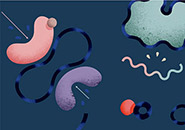Research Summary
Eric Wieschaus's laboratory investigates the genetic mechanisms controlling pattern formation and cell shape change during Drosophila development.
A major goal of my laboratory is to understand the mechanisms that control changes in cell size, shape, and position during embryonic development. The cytoskeletal components and adhesive factors that produce these changes are the same in most organisms; many have been identified using cell biological and biochemical techniques. Before we began our analyses, however, the genes that control transitions between developmentally specific configurations and stages were not known. Drosophila embryos provided a useful system to identify such genes, not only because of their sophisticated genetics but also because each cell shape change and each restructuring of the cytoskeleton is tightly coupled to the developmental pathways governing cell fate. Much of our past work has been directed at identifying the genes that control cell fate in Drosophila. We are currently defining the connection between such cell fate genes and the morphological changes that are their immediate consequences.
Maternal Patterning Genes and the Accuracy of Cell Fate Determination
Cells along the anterior-posterior axis of the Drosophila embryo are assigned specific fates based on gradients of maternally supplied transcription factors. So far, the best-studied example among these is the anterior morphogen Bicoid (BCD). High concentrations of BCD determine anterior cell fate by activating transcription of downstream gap genes such as hunchback (hb) and orthodenticle (otd). To understand how the BCD gradient arises during development, we have compared the changing distribution of fluorescently tagged BCD protein in living embryos to that of the corresponding RNAs localized to the anterior end of the egg during oogenesis. By coupling these analyses to genetic experiments that alter the overall egg dimension or BCD's mobility between the nucleus and cytoplasm, we have found that the gradient is remarkably robust. Although concentrations between adjacent cells vary by only 10–15 percent, the differences are sufficiently reproducible to allow individual cells to activate distinct patterns of gene expression.
We have extended these analyses to the other maternal coordinate systems that have been identified in Drosophila (Nanos and Torso) and will determine whether they also produce similarly precise transcriptional responses. If so, the maternal gradients in Drosophila embryos may provide unique generalizable insights into the mechanisms that allow simple diffusible cell signals to establish reproducible boundaries between cells of different fate in development.
Cell Shape Changes and Morphogenetic Movements During Gastrulation
Once cells have been programmed to the appropriate cell fates in the embryo, they initiate local behaviors that transform the morphology of the embryo. In Drosophila, these morphogenetic movements begin at the blastoderm stage and provide a useful handle on the cell biological mechanisms that control cell shape. Our recent work has focused on two such morphogenetic events, the invagination of mesodermal precursor cells on the ventral side of the embryo and the infolding of the dorsal ectoderm during gastrulation. To study these two phenomena, we have developed two-photon imaging strategies that allow tracking of individual cells, and high-throughput computational tools to quantify their changes in morphology. We find that cell shape change in the two regions is driven by different cell biological mechanisms. In the mesoderm, infolding and invagination are driven by a pulse-like accumulation of myosin on the cell surface that drives apical flattening and constriction. Morphological changes in the dorsal ectoderm, on the other hand, seem independent of myosin and are associated instead with a basal shift in cadherin adhesive junctions. The choice between these two very different mechanisms may reflect the different prospective significance of the two tissues. Following their invagination, mesodermal cells undergo a classic epithelial-mesenchymal transition (EMT), whereas cellular junctions in dorsal epithelium remain intact.
In the mesoderm, our measurements suggest that all quantifiable aspects of early morphological change (e.g., apical constriction, myosin accumulation, cell lengthening along the apical-basal axis, the movement of the nucleus toward the basal side) proceed in small temporal increments correlated with myosin accumulation in the apical-most region of each cell. These results point to a simple mechanical model where volume conservation and constriction-induced cytoplasmic flow account quantitatively for the observed change in cell shape. To test this model, we have developed protocols to measure the viscoelasticity of the cytoplasm and resistance of the cell membranes. These experiments involve tracking fluorescent beads injected into the cytoplasm of the living embryos or attached to the cell membrane. By following the redistribution of both populations of beads during cell shape change, we can reconstruct cytoplasmic flows globally in the embryo and relate them to shear forces generated on the apical surface due to myosin constriction.
Grants from the National Institutes of Health provided partial support for these projects.
As of April 1, 2013





